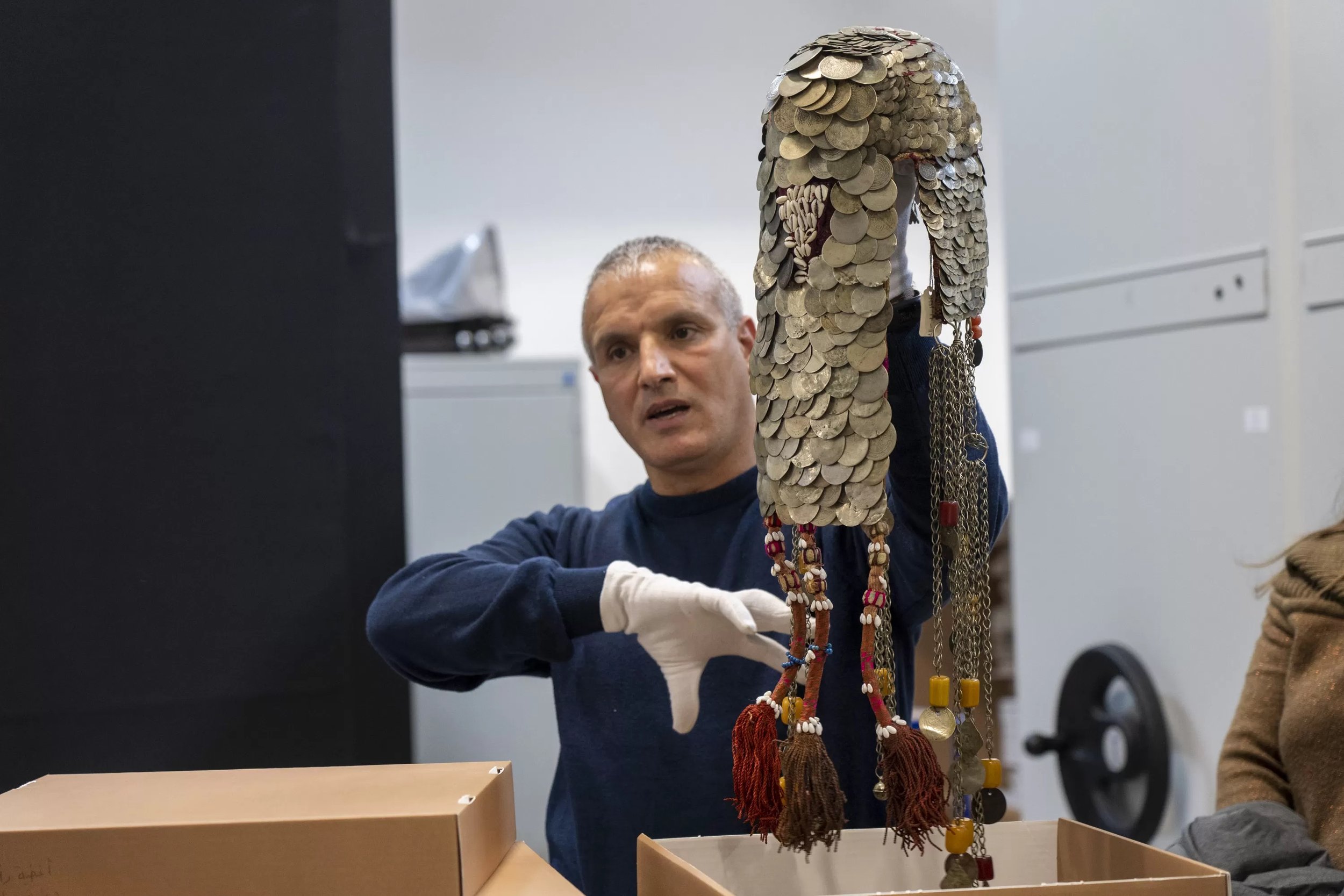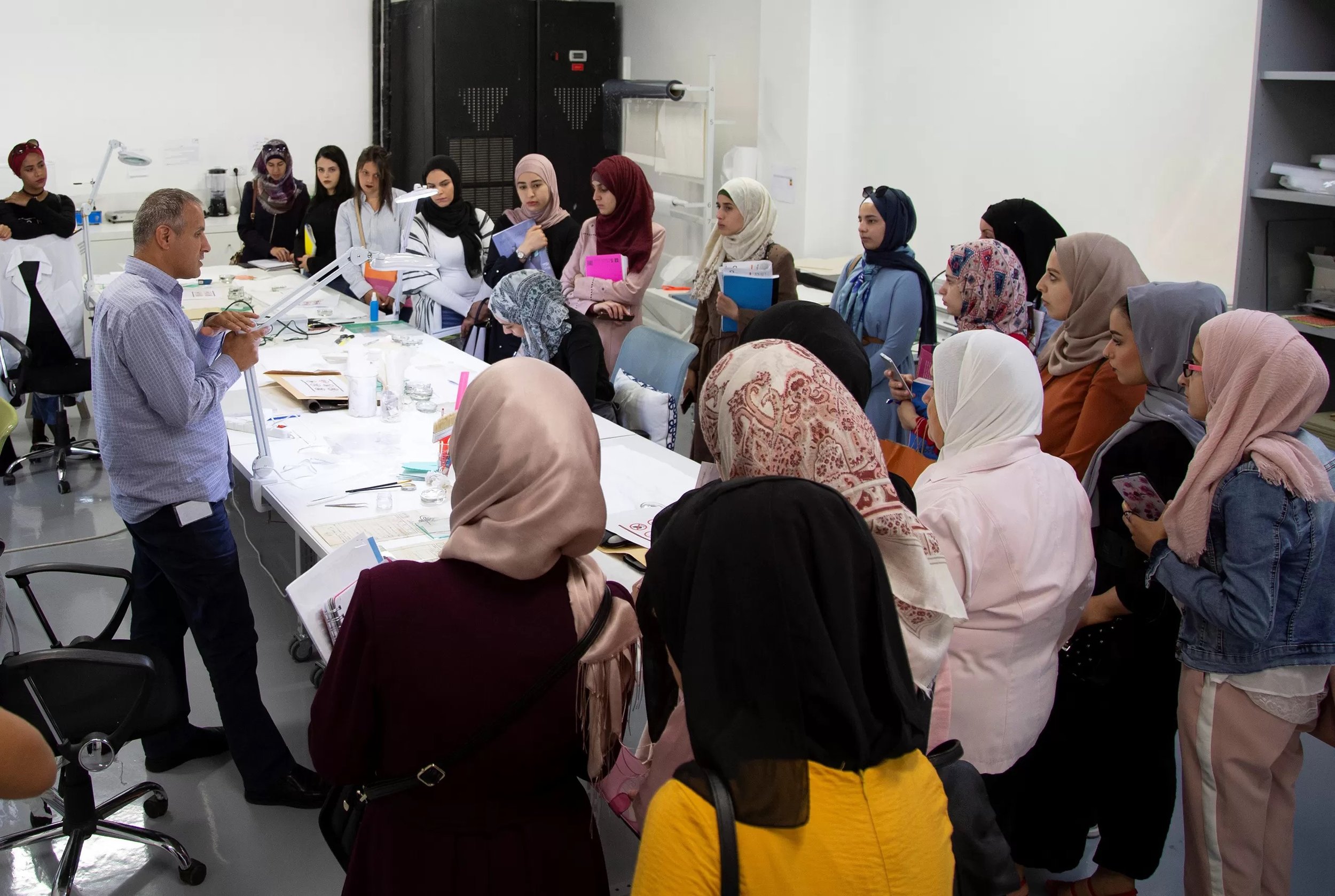Spotlight: Preserving and Portraying culture with curator Baha Jubeh
A veteran in the curation of Palestinian artefacts, textiles and art, Baha Jubeh reveals the importance of what we can learn through the preservation and protection of historical artefacts.
Baha Jubeh giving a presentation at The Palestine Museum. Image courtesy of palmuseum.org, 2024.
Hailing from Jerusalem, Palestine, Baha Jubeh has always had a passion for preserving heritage, leading him to pursue a career in curation. Working within both Dar Al Tifel and The Palestine Museum, the curator has been responsible for exhibitions ranging from traditional Palestinian womenswear to the history of Jerusalem. Previously, Jubeh curated Labour of Love: Embroidering Palestinian History, an outstanding and thoughtful exhibition (which exhibited in Qatar, Palestine and the UK) detailing the intricate designs and history of the Palestinian thobe. “When it comes to Palestinian dress, I understand all of the intricacies involved in them. Looking at a garment, I can not only tell you what region of Palestine it’s from, but also what all of the patterns mean, what the size of the dress means, and why women have decided to embroider the dress in a certain way.”
An expert in Palestinian heritage and traditional garments, Jubeh’s interest in the field began as a child growing up in the Old City of Jerusalem. “My interest in culture and heritage started when I was very young as I really enjoyed history lessons at school and knew that when I went to university, I would want to study history and archaeology.” Whilst a student at Bir Zeit University, Jubeh developed a particular interest in heritage and preservation, leading him to begin his career in the world of curation. “There is a museum of heritage that is part of the university, so I worked alongside them, tracing back the history of old buildings and ruins in the area. From this, I also began developing an interest in curation, so I started to read more and more about the geography of Palestine.” During this period, the young curator began connecting with other cultural centres - including the Mahmoud Darwish Museum, Dar Al Tifel, and the Palestine Museum - whilst also reaching out to private collectors across the region. From branching out and connecting with different circles, Jubeh’s knowledge continued to expand and grow and as a result, he became an encyclopaedia of Palestinian artefacts. “I started building relationships with all of these different groups of people, and it got to the point that when they had any questions they would come to me because I would be able to recall all of the different types of artefacts and textiles that existed. I didn’t want to keep any of my knowledge to myself - quite the opposite really. If you don’t pass on this type of information to other people then it’s gone and doesn’t exist.”
Jubeh’s passion for sharing his research and findings comes from his mission to represent the true identity of Palestinian heritage, which is why the exhibitions he works on aim to have a wider reach and more diverse audience nowadays – as with the Labour of Love exhibition. “We have to portray these artefacts in a way that is not only nostalgic, but also convincing with the right facts and information. We can’t always just show the objects that are beautiful or intact because, as Palestinians, we want to showcase the things that are beautiful about our culture. For example, a tattered thobe gives us more insight into how the traditional Palestinian woman worked in her home.” Jubeh continues to reveal that his approach to portraying Palestinian heritage is not restricted to traditional embroidery and dress, and that acknowledging the wider context of heritage is also related to the geographical landscape, art and jewellery.
Baha Jubeh at the Palestinian Museum. Image courtesy of palmuseum.org, 2024.
One example of Jubeh’s approach of contextualising the history of Palestine in a niche yet informative way is through his 2021 exhibition, Printed in Jerusalem: Mustamloun, which explored the relationship between Jerusalemites and print publications narrating politics, education, culture and tourism in Jerusalem. “Palestinian heritage isn’t just restricted to embroidery or dress, and it would be a shame to ignore the rest of our culture and not protect it in the same way. For example, you have tools for agriculture, music and folklore to look at.”
Today, many contemporary creatives across various mediums are continuing to comment on Palestinian identity in an innovative and new way, including Gazan artists Hazem Harb and Malak Mattar, and fashion designer and founder of Nöl Collective Yasmeen Mijalli to name a few. Baha Jubeh believes that this is another method of preserving and portraying culture; he suggests that this is an important approach to take whilst looking into the future of exhibitions on the theme of Palestinian heritage in order to attract, engage and inform new audiences. “What’s important is that this generation and the creatives that are producing work are doing their research. There were famous artists from the 1970s and 1980s, like Sliman Mansour and Nabil Anani, who were creating artworks from their lived experiences of Palestine, so it’s really key that there is a lot of thought and research that goes into these new works, and most importantly, that there is a lot of emotion and humanity shown. Of course, we should respect heritage and history and it should contribute to guiding us - but it shouldn’t stop us. We have to keep progressing and moving forward.”


